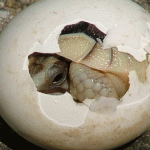
The question of how the giraffe got its long neck has long been debated by scientists throughout the world. Since the days of Charles Darwin, the dominant theory has been that the giraffe’s neck developed as an increasing advantage in reaching food high in trees.
However, Darwin’s theory has long been challenged by the idea that neck length may have been the result of giraffe males’ attempts to attract females.
It is common for male giraffes to fight over females. They cross ‘swords’ with their 2-3-metre-long necks, and the hairy horns on their heads can cause severe damage. The longer the neck, the better the chances of hurting the opponent.
The theory is now supported by a series of fossil finds of a head-butting ancestor. The first fossils were discovered in 1996 in the Xinjiang region of Northern China, but scientists then believed that they had found a remote relative of cattle or sheep. But after new discoveries and CT scans, scientists have established that this mammal is a relative of the giraffe.
The species existed some 17 million years ago, and has been named Discokeryx xiezhi after a one-horned mythological creature from China. Unlike modern giraffes, Discokeryx xiezhi had a short neck, and on top of its head there was a bulging, hard plate that was used to combat other males in the battle for females.
The small giraffe was roughly the size of a sheep, so it is highly unusual that its skull was up to 2.5cm thick, making the head ideal for fights. The animal’s vertebrae are also extremely powerful, so that Discokeryx xiezhi could resist the hard blows of colliding heads.
When Discokeryx xiezhi became extinct, the modern giraffe continued to develop its long neck in an attempt to win fights and attract females. Via the passing of genes to new generations by winning giraffes over two million years, the modern giraffe has its long neck. The scientists suggest that reaching food higher in trees was merely a side effect of evolution from these mating fights.






